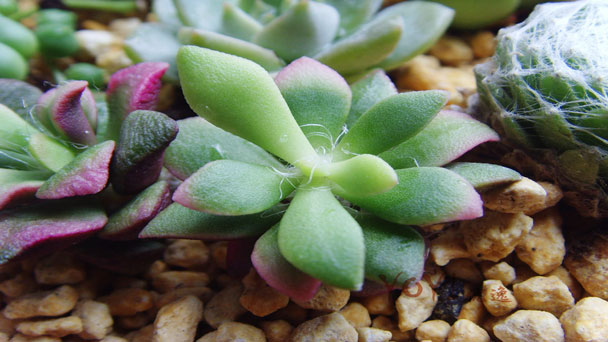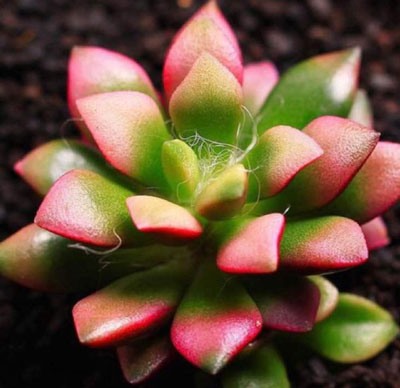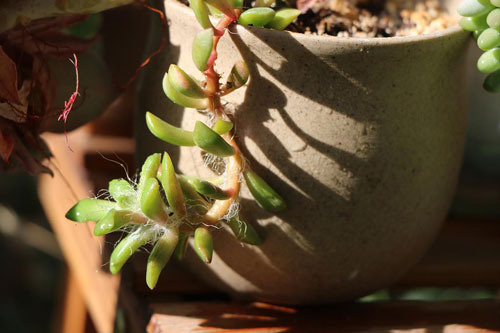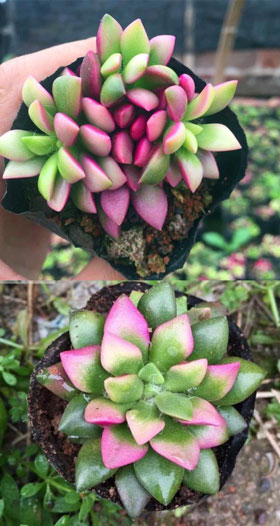Anacampseros Rufescens (Sand Rose) Grow & Care Guide
Written by Iris
Oct 09 2021

Anacampseros Rufescens (Sand Rose) is native to Namibia and is a variety of succulents with white brocade spots. The top leaf is spread out like a lotus, and the leaf surface is thick. Anacampseros Rufescens prefers a sunny, warm place, but avoid leaving it in the hot sun for a long time. The height of the plant is only 5 cm, with white filamentous hairs between the leaves and small rose-colored flowers.

Once it is dry, you can either place the leaf flat on the top of the soil mixture or tuck the ends of the leaf into the soil. It takes about two weeks for the leaves to start producing roots and a few more weeks to produce baby Anacampseros rufescens.
Outdoors, just select the place with plenty of bright, partial light. They can tolerate full sun but need to get used to it gradually. Are you planning to keep them in the full(indirect) sun to see the color potential? You can start by putting them for a few hours in the morning sun and increase gradually. Importantly, don't extend more than 4 hours and don't let them in the intense sun on hotter days. Moreover, keep an eye on the plant to keep it safe from scorching by the bright sun. To be on the safe side, it is best to avoid direct sunlight exposure.
Light requirement and resistance of baby plants are usually lesser. Thus, avoid placing them in intense light.
Leggy and elongated foliage is called etiolation. Etiolation and pale foliage are the possible symptoms of inadequate light and resulting in poor nutrition. The plant body actually stretches out as a natural mechanism to get the required light. If the situation persists, the plant will eventually get weak and growth will be stunned.
If you prefer to keep your plant inside the house, know that you don't need to water them as frequently as you’ll have to when they are outdoors. The combination of the plant not getting enough light and more water than necessary is enough to kill off your Anacampseros rufescens plants, so be vary of these factors.
You can tell whether your plant is ready for the next watering session by checking the top one inch of the soil. If that top one inch of soil has dried out, you need to water your Anacampseros rufescens. If it's your first time dealing with these plants, remember that underwatering is always better than overwatering.
Anacampseros rufescens prefers a daytime humidity of 50% to 70%. Please note that this is based on the relative humidity felt by your skin. If you cannot feel any moisture in the air, then it means that there is too little humidity and needs to be increased. Conversely, if everything feels wet or sticky, it most likely has an excess amount of humidity which should be reduced for optimum growth conditions.
If there is condensation on the windows near a plant, then it means that the room has too much humidity. The plant will not grow, and leaves can get burned.
The plant needs to be trimmed and shaped often, so it doesn't grow out of control. This will help make sure you get a healthy shape for your succulent and keep its appearance up longer than if left unchecked. When you first get your plant, start by trimming off any dead or damaged leaves. This will help make it look nicer and healthier.
After a few months, retake some time to shape the plant as desired – cut off all of the old growth on the outside edge to create new growing points closer towards its center. Cut back any branches that have grown too long and remove lower leaves if they’re not needed anymore (then fertilize). You can pinch out a tip that is growing the wrong way by pinching it. This is better if more than one node is growing in that place because then only one branch will grow, not two branches fighting for space.
Mealybugs – Mealybugs are often seen in the new growth of succulents, they can be seen hiding among the leaves and it causes disfiguring of the plant. When they are found on the roots, they can multiply and if not removed immediately, they can cause the decline of the plants. The common sign of mealybugs infestation is withering of leaves and if not caught as soon as possible, it can even cause the death of the succulent. Get rid of these pests by applying isopropyl alcohol on the affected areas.
Red spider mites – Red spider mites are an eighth of an inch long. They live on the underside of the leaves or the areas where the leaves and the stem meet. They spin webs to protect them from predators. They feed on the succulent's body by puncturing the top layer of the plant’s skin and suck on its juices. A whole colony of red spider mites can cause a plant to wither in just a few days. You can use neem oil or insecticidal soap to get rid of these pests.
Anacampseros telephiastrum'Variegata': Lance-shaped green leaves marked with creamy pink or yellow. Has pink flowers in summer.
Anacampseros retusa: Rounded or lance-shaped leaves. Blooms are pinkish or pale purple.
Anacampseros filamentosa: Small, rounded or oval leaves densely covered with white hairs. Pink blooms in summer.
Where to Grow Anacampseros Rufescens (Sand Rose)How to Grow Anacampseros Rufescens (Sand Rose)Anacampseros Rufescens Propagation with SeedsAnacampseros Rufescens Propagation with Stem CuttingsAnacampseros Rufescens Propagation with Leave CuttingsAnacampseros Rufescens Propagation with DivisionHow to Care for Anacampseros Rufescens (Sand Rose)Anacampseros Rufescens Lighting RequirementsAnacampseros Rufescens Soil CareAnacampseros Rufescens WateringAnacampseros Rufescens Temperature & Humidity CareAnacampseros Rufescens Fertilizer CareAnacampseros Rufescens Pruning CareAnacampseros Rufescens Pests & Diseases CareVarieties of Anacampseros Rufescens (Sand Rose)Anacampseros Rufescens (Sand Rose) FAQIs the Anacampseros Rufescens Toxic to Pets?Is the Sand Rose succulent frost hardy?Is it possible to grow indoor as houseplant?
Where to Grow Anacampseros Rufescens (Sand Rose)
Anacampseros rufescens is not cold hardy, so if you live in a zone that gets colder than 20° F (-6.7° C), it's best to plant this succulent in a container that can be brought indoors. It does well in full to partial sun. Plant in an area of your garden that gets 4 hours of sunlight a day. If planting indoors, place in a room that gets a lot of sunlight, such as near a southern-facing window (if you're in the Northern Hemisphere).
How to Grow Anacampseros Rufescens (Sand Rose)
Propagate anacampseros Rufescens from seeds, cuttings, or division.Anacampseros Rufescens Propagation with Seeds
When growing The Anacampseros rufescens from seeds, make sure that the temperature is around 19 to 24 ° C or 66 to 75° F. Ideally this is done during the summer or by using grow lights. The seeds should then be placed in well-draining soil, and only watered once the soil is completely dry.Anacampseros Rufescens Propagation with Stem Cuttings
- Use gardening shears to cut one or more healthy leaves from the rosette.
- Cut near the base of the rosette and allow the cuttings to dry for several days.
- After the cut section scars over, dip the tips of the cuttings in rooting hormone powder.
- Plant offsets or stem cuttings in gritty soil using the ratio described above.
- Saturate the soil once after planting.
- Wait to water the plant until new growth appears, and the soil is completely dry.
Anacampseros Rufescens Propagation with Leave Cuttings
The one thing that you should keep in mind when you're trying to propagate Anacampseros rufescens from leaves is that not all leaves will make it. This type of propagation takes a lot longer and requires a lot more patience. To propagate this type of plant from a leaf, you need to remove a complete leaf, including the base, and let it dry for a day.Once it is dry, you can either place the leaf flat on the top of the soil mixture or tuck the ends of the leaf into the soil. It takes about two weeks for the leaves to start producing roots and a few more weeks to produce baby Anacampseros rufescens.
Anacampseros Rufescens Propagation with Division
Propagating by division is the easiest method as the plant freely produces offsets. The smaller rosettes spread across the pot or garden and are connected through the complex root system.- Dig up the soil around the plants and carefully lift the offsets from the ground.
- Loosen the soil to find where the roots connect to the mother plant.
- Use sharp gardening shears to cut the offsets free.

How to Care for Anacampseros Rufescens (Sand Rose)
Anacampseros Rufescens Lighting Requirements
The plant shows beautiful colored foliage in the presence of bright light. Partial bright sun to partial shade is optimum for the Anacampseros rufescens sunrise plant. If you are keeping them indoors, make sure to select the brightest spot in the house. East facing window is the top priority. Moreover, West and South facing windows are also suitable as the second option. A minimum of 4 hours of bright light is essential for healthy foliage. However, in the absence of natural light, you can keep the plant around a fluorescent bulb to fulfil its requirements.Outdoors, just select the place with plenty of bright, partial light. They can tolerate full sun but need to get used to it gradually. Are you planning to keep them in the full(indirect) sun to see the color potential? You can start by putting them for a few hours in the morning sun and increase gradually. Importantly, don't extend more than 4 hours and don't let them in the intense sun on hotter days. Moreover, keep an eye on the plant to keep it safe from scorching by the bright sun. To be on the safe side, it is best to avoid direct sunlight exposure.
Light requirement and resistance of baby plants are usually lesser. Thus, avoid placing them in intense light.
Leggy and elongated foliage is called etiolation. Etiolation and pale foliage are the possible symptoms of inadequate light and resulting in poor nutrition. The plant body actually stretches out as a natural mechanism to get the required light. If the situation persists, the plant will eventually get weak and growth will be stunned.
Anacampseros Rufescens Soil Care
Soil preparation is something that every plant needs to grow properly, and anacampseros rufescens is no different. It needs well-draining soil to thrive. Gritty soil with some organic material added is the ideal soil type for the optimal growth of Anacampseros rufescens. The pH of the soil should be either neutral or mildly acidic (6.1 to 6.5) or mildly alkaline (7.6 to 7.8).Anacampseros Rufescens Watering
The watering schedule for Anacampseros rufescens varies with the type of climate. They are able to survive in dry conditions, but they need adequate watering for maximum and healthy growth. In warmer months, you should water your Anacampseros rufescens every week and cut down the watering to once every 2 weeks when it turns cooler. When winter season arrives, the best practice is to cut down the watering completely and rely on rainwater. More water than is necessary water results in these plants rotting and dying.If you prefer to keep your plant inside the house, know that you don't need to water them as frequently as you’ll have to when they are outdoors. The combination of the plant not getting enough light and more water than necessary is enough to kill off your Anacampseros rufescens plants, so be vary of these factors.
You can tell whether your plant is ready for the next watering session by checking the top one inch of the soil. If that top one inch of soil has dried out, you need to water your Anacampseros rufescens. If it's your first time dealing with these plants, remember that underwatering is always better than overwatering.
Anacampseros Rufescens Temperature & Humidity Care
Anacampseros rufescens thrives in temperatures from 45-65 degrees Fahrenheit (USDA zone 11). During the winter, they prefer a temperature between 55 to 60 degrees F°. Keep your Anacampseros out of drafts and away from heating vents or fireplaces where it might get too hot. In summer, keep them well ventilated with plenty of water to stay at least 60 degrees F° but no warmer than 75 degrees F° for optimum growth rate. Anacampseros rufescens can take a small amount of frost, but it is not recommended to make them cold. It should also be noted that they are sensitive to moisture loss and start drooping if the air becomes too dry for an extended period.Anacampseros rufescens prefers a daytime humidity of 50% to 70%. Please note that this is based on the relative humidity felt by your skin. If you cannot feel any moisture in the air, then it means that there is too little humidity and needs to be increased. Conversely, if everything feels wet or sticky, it most likely has an excess amount of humidity which should be reduced for optimum growth conditions.
If there is condensation on the windows near a plant, then it means that the room has too much humidity. The plant will not grow, and leaves can get burned.
Anacampseros Rufescens Fertilizer Care
Established plants should be fertilized once a year in the spring. To get established, use an all-purpose fertilizer to feed flowers and foliage according to the label directions. For mature plants, mix or dissolve 20% of your usual amount of dry fertilizer into the water until it is entirely dissolved before watering as usual. Do not overfeed Anacampseros Rufescens succulents with nitrogen. This causes them to grow too quickly then die off quicker than desired because they have outgrown their support system (their container). You can also try giving them some phosphorous, which will make more blooms form on the plant if you want that kind of look for indoors or outdoors decorating purposes.Anacampseros Rufescens Pruning Care
Many people are under the misconception that Anacampseros rufescens plants can grow without pruning, but this is not true.The plant needs to be trimmed and shaped often, so it doesn't grow out of control. This will help make sure you get a healthy shape for your succulent and keep its appearance up longer than if left unchecked. When you first get your plant, start by trimming off any dead or damaged leaves. This will help make it look nicer and healthier.
After a few months, retake some time to shape the plant as desired – cut off all of the old growth on the outside edge to create new growing points closer towards its center. Cut back any branches that have grown too long and remove lower leaves if they’re not needed anymore (then fertilize). You can pinch out a tip that is growing the wrong way by pinching it. This is better if more than one node is growing in that place because then only one branch will grow, not two branches fighting for space.
Anacampseros Rufescens Pests & Diseases Care
The sunrise succulent can be attractive to different types of insects, but if properly taken care of, it can be pest-free. Make sure to grow in a cactus/succulent soil mix rich in minerals with good ventilation and preferable light conditions. If the plant suddenly exhibits any signs of health decline, check it for any pest infestation. Pests can cause stunted growth, scarring, or even the plant's death.Mealybugs – Mealybugs are often seen in the new growth of succulents, they can be seen hiding among the leaves and it causes disfiguring of the plant. When they are found on the roots, they can multiply and if not removed immediately, they can cause the decline of the plants. The common sign of mealybugs infestation is withering of leaves and if not caught as soon as possible, it can even cause the death of the succulent. Get rid of these pests by applying isopropyl alcohol on the affected areas.
Red spider mites – Red spider mites are an eighth of an inch long. They live on the underside of the leaves or the areas where the leaves and the stem meet. They spin webs to protect them from predators. They feed on the succulent's body by puncturing the top layer of the plant’s skin and suck on its juices. A whole colony of red spider mites can cause a plant to wither in just a few days. You can use neem oil or insecticidal soap to get rid of these pests.

Varieties of Anacampseros Rufescens (Sand Rose)
Anacampseros crinita: Fleshy, crowded leaves growing in a spiral with pale green to reddish green or pink blooms in summer.Anacampseros telephiastrum'Variegata': Lance-shaped green leaves marked with creamy pink or yellow. Has pink flowers in summer.
Anacampseros retusa: Rounded or lance-shaped leaves. Blooms are pinkish or pale purple.
Anacampseros filamentosa: Small, rounded or oval leaves densely covered with white hairs. Pink blooms in summer.

Anacampseros Rufescens (Sand Rose) FAQ
Is the Anacampseros Rufescens Toxic to Pets?
There is not much information available if this specific succulent is poisonous to cats and dogs. If you suspect your pet suffering from poisoning after consumption of this plant, you must immediately contact your local vet or the ASPCA Animal Poison Control Center.Is the Sand Rose succulent frost hardy?
Sand Rose succulents will not survive a hard frost but can still be fine generally until the temperature reaches under 20 degrees Fahrenheit. Just don't keep this succulent outdoors for too long during these temperatures and you will be just fine. If you do live in a very cold climate you can certainly grow these succulents in containers indoors or outside year round with a quality mini greenhouse.Is it possible to grow indoor as houseplant?
Yes, when grow indoor need to put less water because it's there are less factor that drain the soil, but if there ventilator, air condition and heaters, be aware that it's dry the air and take care of the plant.Latest Updated
- Benefits of Bugleweed - 7 Science-backed Health Benefits
- Bugleweed Dangers & Side Effects - Is It Poisonous?
- How to Plant Evergreen Trees - What You Should Know
- When to Plant Evergreens - Grow Guide for Evergreen Trees
- 12 Wonderful Evergreen Shrubs for Your Garden
- 12 Popular Evergreen Plants with Pictures for Beginners
- When And How To Prune A Lilac Bush Like a Pro
- How to Grow & Care for Lilac Vine (Hardenbergia Violacea)
- Japanese Lilac Tree (Syringa Reticulata) Care & Propagation Guide
- Shumard Oak Pros and Cons - What to Know
Popular Articles
- Winter maintenance of Antirrhinum Majus
- How to Grow Terminalia Mantaly Tree
- How to Grow and Care for Crossostephium Chinense
- How to grow Antirrhinum Majus in spring
- Peristeria Elata (Dove Orchid) Profile: Info & Care Guide
- Underwatered Snake Plant (Sansevieria Trifasciata) - Signs And How To Fix
- How to Care for Brazilian Jasmine Plant (Mandevilla Sanderi)
- How to Grow & Care for Graptopetalum Purple Delight in Summer
- Rosa Chinensis (China Rose): Plant Growing & Care Tips
- How to Care for Baby Sun Rose (Aptenia Cordifolia)